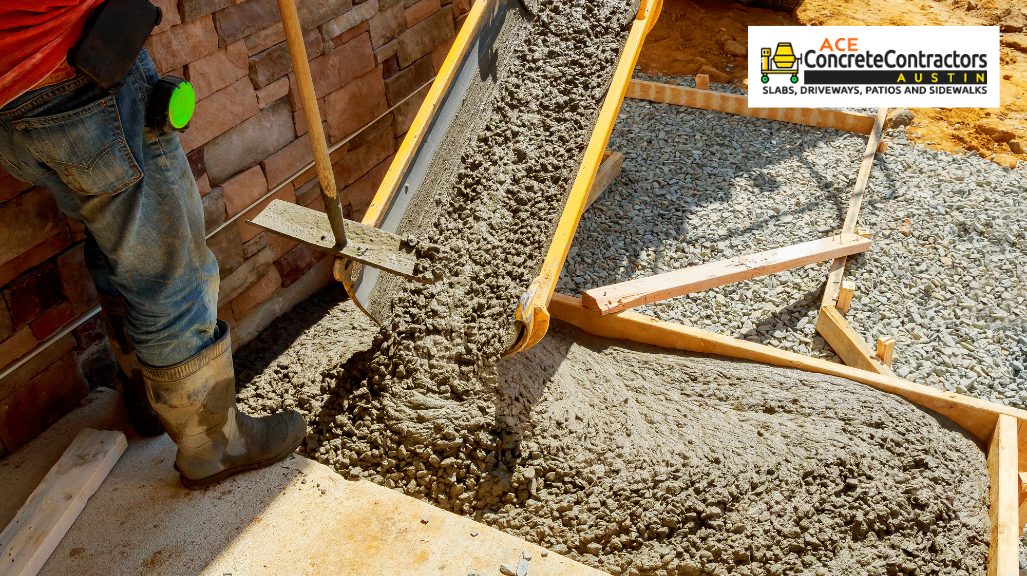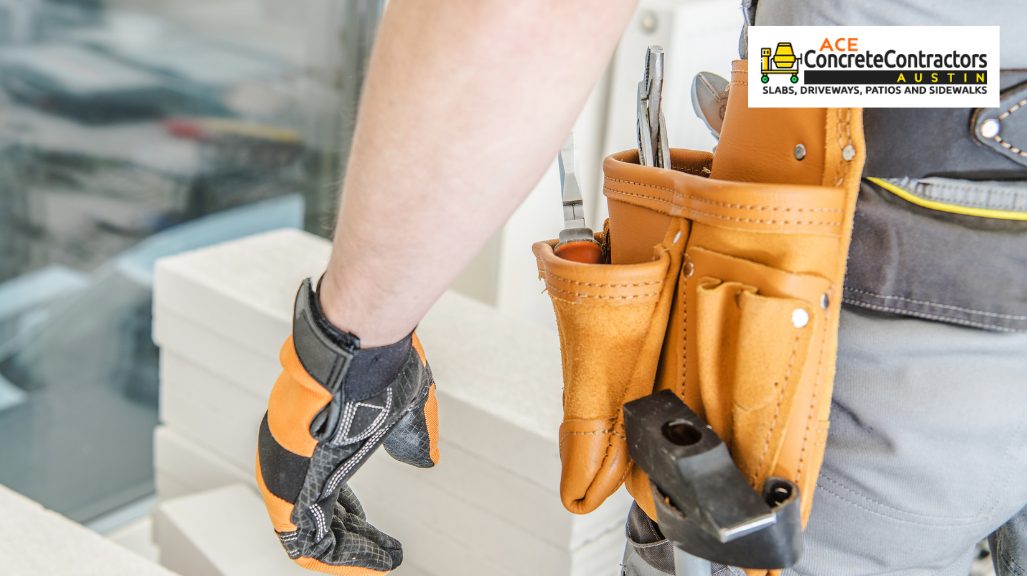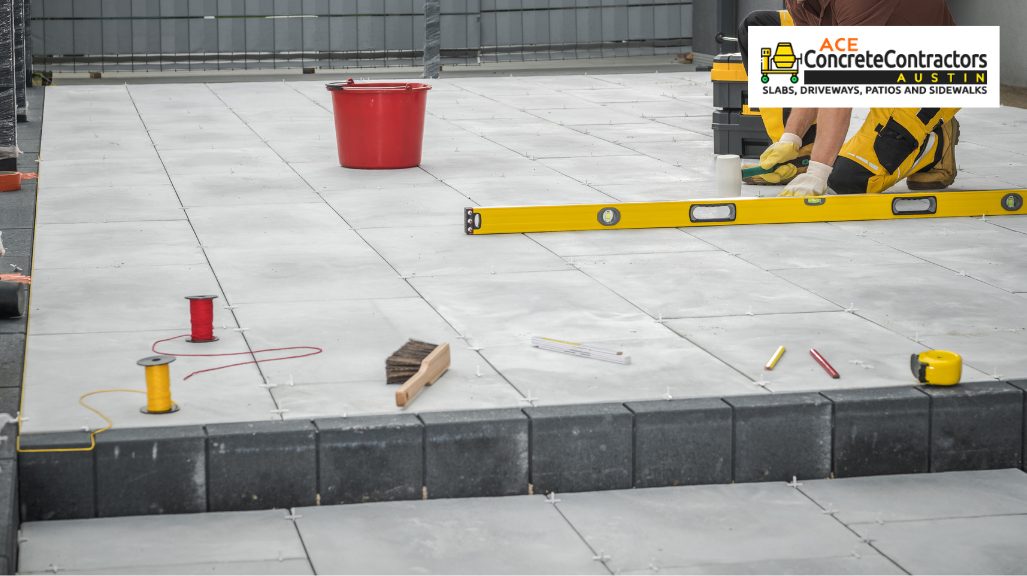
Table of Contents
Concrete contractors might not grab headlines like architects or interior designers, yet their role is foundational in bringing construction visions to life. This field, often underestimated, thrives on precision, expertise, and the ability to transform raw materials into lasting structures. The essence of a successful concrete project lies in the partnership between a homeowner and their contractor.
This relationship is built on clear communication, mutual understanding, and shared expectations. Questions to ask your concrete contractor, especially when working with Ace Concrete Contractors Austin – Slabs, Driveways, Patios, and Sidewalks, include their experience level, project timeline, cost estimates, quality assurance practices, change management, credentials, and communication plans. Each of these areas contributes to a project’s smooth execution.
Understanding the contractor’s experience through past project examples and references ensures they can handle your needs. A detailed project timeline and cost breakdown protect against unexpected delays and expenses, while quality assurance and change management practices safeguard your investment. Knowing the contractor’s credentials provides peace of mind, and a solid communication plan keeps you informed every step of the way.
The following sections will delve into these critical questions, offering insights to help you select a concrete contractor who will meet and exceed your expectations, ensuring your project stands the test of time.
What is the contractor’s experience level?

When selecting a concrete contractor, their experience level is a crucial factor. This involves exploring the types of projects they’ve completed and the quality of their work. Asking for examples of similar projects they’ve handled gives you insight into their capability to manage your specific requirements.
Additionally, requesting references or access to a portfolio allows you to verify their expertise and the satisfaction of past clients. An experienced contractor brings a wealth of knowledge and the ability to foresee and navigate potential challenges, ensuring your project is completed to the highest standard.
Similar project examples?
Asking for similar project examples is critical to understanding if a contractor has the right experience for your job. This question helps you gauge whether they have successfully tackled projects of similar scale and complexity. For instance, inquire if they’ve completed similar residential projects when installing a residential driveway.
Similarly, ask for examples of commercial parking lots within that specific context. This will give you a clearer picture of their expertise in areas relevant to your project.
Examples of Project Types to Inquire About:
- Residential driveways
- Commercial parking lots
- Decorative concrete patios
- Concrete foundations for new buildings
- Retaining walls
Are references or portfolios available?
Researching references or a portfolio proves the contractor’s work quality and reliability. It’s essential to verify their capability and ensure they meet your expectations. When reviewing a portfolio, look for before and after photos, details about the project scope, and any challenges that were overcome.
This can give you a sense of the contractor’s problem-solving abilities and attention to detail.
Tips for Evaluating References and Portfolios:
- Before and After Photos: Look for transformations that align with the type of project you’re planning.
- Project Scope: Ensure the contractor has experience with projects of similar size and complexity.
- Challenges Overcome: How obstacles were handled indicates the contractor’s expertise and adaptability.
- Client Testimonials: Feedback from past clients can provide insights into the contractor’s reliability, communication, and quality of work.
By asking for specific project examples and understanding how to evaluate references or a portfolio effectively, you can select a concrete contractor with the right experience level for your project, ensuring a successful partnership and outcome.
What is the detailed project timeline?

A detailed project timeline is crucial for the smooth execution of any concrete project. It outlines the start date, completion date, and critical milestones. This timeline serves as a roadmap, guiding you and the contractor through each project phase.
Understanding the timeline helps manage expectations and ensures the project stays on track. It also allows for better planning and coordination, reducing the likelihood of unexpected delays. Asking your contractor for a detailed timeline is essential for keeping your project within the desired timeframe and budget.
Start date and completion date?
Clarifying the start date and completion date with your contractor sets clear expectations for when the project will begin and when it is anticipated to end. This ensures both parties are aligned on the project’s timeframe, facilitating better planning and resource allocation.
Example of Timeline Impact:
- Weather Delays: Inclement weather, such as heavy rain or extreme cold, can delay the start date or prolong the project duration. For instance, concrete pouring cannot proceed during a heavy rainstorm, potentially pushing back the start date.
- Supply Chain Issues: Delays in material delivery due to supply chain disruptions can also affect the project timeline. For example, if the specific type of concrete mix is back-ordered, the project’s start or completion date could be delayed.
Milestones and checkpoints?
Discussing milestones and checkpoints with your contractor helps monitor the project’s progress against the planned timeline. These markers act as progress indicators, enabling adjustments if the project deviates from its intended path and ensuring it stays on schedule.
Common Milestones:
- Site Preparation Completion: The site is cleared, graded, and ready for construction. This first significant milestone sets the stage for the rest of the project.
- Framing and Formwork: The installation of forms that will hold the concrete in place until it hardens. This step is crucial for shaping the concrete to the desired design.
- Pouring: The actual pouring of concrete into the prepared forms. This milestone is significant as it represents the project taking physical shape.
- Curing: Concrete needs time to cure and reach its full strength after pouring. This period is critical for ensuring the durability and longevity of the structure.
- Finishing Touches: The final steps include sealing and applying finishes to the concrete surface. This milestone marks the completion of the concrete work, pending any landscaping or additional features.
What does the cost estimate include?

A comprehensive cost estimate is crucial for any concrete project, as it outlines all expenses. This includes the cost of materials, labor, and any other potential costs that might arise during the project. A detailed understanding of what the estimate includes helps in accurate budgeting and prevents unexpected expenses.
It’s important to discuss with your contractor the possibility of additional costs and how these would be managed. A detailed cost estimate promotes transparency between you and the contractor, contributing to smoother project execution.
Detailed breakdown of materials and labor?
A detailed breakdown of materials and labor provides transparency, showing exactly what your investment covers. This helps compare costs and ensure you get fair value for the services provided.
Cost Breakdown Table
Cost Category | Description | Estimated Percentage | Notes |
Materials | Concrete, rebar, formwork, etc. | 60% | Based on project size and scope |
Labor | Preparation, pouring, finishing | 30% | Varies with project complexity |
Equipment Rental | Mixers, vibrators, finishing tools | 5% | Required for larger projects |
Administrative | Permits, inspections | 3% | Essential for project legality |
Contingency | Unforeseen expenses | 2% | Buffer for unexpected costs |
Potential for additional costs?
Discussing potential additional costs upfront prepares you for unforeseen expenses that may arise. This could include changes in material prices, unexpected labor needs, or adjustments in project scope. Planning for such contingencies can alleviate stress and avoid project overruns.
Examples of Potential Additional Costs
Potential Additional Cost | Description | Mitigation Tips |
Ground preparation issues | Unstable soil requiring additional work | Conduct a thorough site assessment early |
Material price increases | Fluctuations in the cost of concrete or steel | Lock in prices with suppliers when possible |
Weather-related delays | Rain or extreme temperatures delay work | Include buffer days in the project timeline |
Changes in project scope | Client requests for additional features or design changes | Clearly define project scope upfront |
Keep Discovering: How Long Concrete Slab Dry
How is quality assurance handled?

Quality assurance in concrete projects is pivotal, ensuring the longevity and durability of the construction. It involves specific quality control measures and durability testing methods to meet established standards. Quality assurance processes are designed to detect and correct any deficiencies early on, preventing costly repairs or failures in the future.
Discussing how your contractor approaches quality assurance gives you insight into their commitment to delivering a high-quality project. It’s essential to understand their practices, from the materials to the techniques applied, to ensure your project stands the test of time.
Specific quality control measures?
Quality control measures ensure the project meets all required standards and specifications. These measures can include rigorous material testing, adherence to building codes, and continuous on-site supervision. Understanding the contractor’s approach to quality control helps assess their ability to deliver a durable and safe structure.
Quality Control Measures Table
Quality Control Measure | Description | Purpose |
Mix Design Verification | Ensuring the concrete mix meets the project’s specific strength requirements | To achieve the desired durability and strength |
Compaction Tests | Assessing the density and void spaces in the concrete | To ensure proper compaction and avoid future structural issues |
Slump Test | Measuring the consistency of the concrete mix | To confirm workability for the project’s needs |
Air Content Test | Determining the volume of air in the concrete | To ensure durability, especially in freeze-thaw cycles |
Curing Method Assessment | Evaluating the procedures for curing concrete | To achieve maximum strength and surface durability |
Durability testing methods?
Durability testing methods predict how well the concrete will hold up over time under various conditions. This might involve testing for resistance to weathering, chemical attacks, and physical wear. Knowing the types of durability tests your contractor uses can give you confidence in your concrete project’s long-term performance and resilience.
Durability Testing Methods Table
Testing Method | Description | Significance |
Freeze-Thaw Resistance Testing | Assessing concrete’s ability to withstand cyclic freezing and thawing | To ensure structural integrity in cold climates |
Permeability Testing | Measuring the ease with which water, air, and substances penetrate concrete | To assess resistance to water and chemical penetration, affecting durability |
Chloride Penetration Test | Evaluating the resistance of concrete to chloride ingress | Important for structures exposed to deicing salts or seawater |
Abrasion Resistance Testing | Testing the surface wear of concrete under traffic or mechanical action | Critical for floors, pavements, and industrial applications |
Carbonation Depth Measurement | Determining the depth of carbonation in concrete | To assess the potential for steel reinforcement corrosion |
How are changes during the project managed?

Managing changes during a concrete project is critical and can significantly impact the timeline and budget. It involves a clear process for requesting changes, which should be outlined by the contractor at the start of the project. This process typically includes evaluating the impact of the requested change on the project’s scope, timeline, and cost.
Communication plays a vital role in this aspect, ensuring that both parties thoroughly document and agree upon any adjustments. Understanding how your contractor handles changes can help you prepare for potential modifications and ensure the project remains aligned with your vision and expectations.
Process for requesting changes?
The process for requesting changes involves clear communication between you and the contractor. Initially, any desired modifications should be formally submitted for review. The contractor then assesses the impact of these changes on the project, providing feedback on possible implications for the project’s scope and execution.
Change Request Process Table
Step | Action | Description |
1 | Identify Need for Change | The client or contractor recognizes a need to modify the project scope, design, or execution. |
2 | Formal Submission | The client submits a formal change request form detailing the desired changes. |
3 | Review & Assessment | The contractor reviews the request, assessing its impact on the project’s timeline, cost, and scope. |
4 | Proposal & Negotiation | The contractor proposes solutions or alternatives, including revised costs and timelines. The client and contractor negotiate terms. |
5 | Approval & Documentation | Once agreed upon, the change is formally approved, and all project documentation is updated to reflect the change. |
6 | Implementation | The contractor implements the change, adjusting project plans and schedules as necessary. |
7 | Monitoring & Reporting | The impact of the change is monitored, with regular updates provided to the client. |
Impact of changes on timeline and cost?
The impact of changes on timeline and cost is a crucial consideration. Modifications can extend the project duration and increase expenses. Understanding how changes affect the overall project helps make informed decisions, ensuring adjustments align with your goals and budget.
Hypothetical Scenario Table
Scenario | Requested Change | Impact on Timeline | Impact on Cost | Notes |
A | Addition of a stamped concrete patio | +2 weeks | +$5,000 | Requires additional materials and labor. |
B | Upgrade to a higher-grade concrete mix | +0 weeks | +$3,000 | No impact on the timeline, but it increases material costs. |
C | Change in project scope to include a retaining wall | +4 weeks | +$10,000 | Significant impact due to additional materials, labor, and equipment. |
D | Delay start date due to client request | +0 weeks (shifted) | +$0 | No direct cost increase, but timeline shifts. |
E | Expedite project completion | -2 weeks | +$8,000 | Increased labor costs to meet the new deadline. |
What are the contractor’s credentials?

The credentials of a concrete contractor play a significant role in ensuring the success and legality of your project. This includes verifying that the contractor has valid licensing appropriate for the scope of your project, which demonstrates their adherence to industry standards and regulations. Additionally, comprehensive insurance coverage is crucial to protect against potential liabilities or accidents during the project.
Checking a contractor’s credentials gives you peace of mind, knowing that you are working with a qualified and prepared professional to handle your project with the utmost care and expertise.
Valid licensing for your project?
Ensuring the contractor has valid licensing for your project is critical. This licensing confirms that they meet the necessary legal and professional standards to undertake your project. It’s a safeguard that protects the integrity and safety of the construction work.
How to Verify a Contractor’s License:
- State Licensing Board: Most states have an online portal where you can verify a contractor’s license status. The portal will also indicate whether the license is for residential, commercial, or both types of projects.
- License Number: Ask the contractor for their license number and use it to check their credentials on the state’s licensing board website.
- Scope of Work: Different projects may require specific licenses. For example, a general contractor’s license covers essential concrete work, but specialized projects require additional certifications.
Comprehensive insurance coverage details?
Comprehensive insurance coverage is essential for any concrete project. It should cover liability, worker’s compensation, and property damage. This insurance protects you and the contractor from unforeseen events and accidents, ensuring that all parties are financially secure throughout the project.
Examples of Comprehensive Coverage:
- General Liability Insurance: Protects against property damage and injury claims resulting from the contractor’s operations.
- Workers’ Compensation Insurance: Covers medical costs and disability benefits if a worker is injured on the job.
- Auto Liability Insurance: Covers damages and injuries resulting from vehicle accidents involving the contractor’s fleet during the project.
How to Verify the Contractor’s Insurance Policy:
- Certificate of Insurance (COI): Request a current COI from the contractor, which should detail the coverage types and limits.
- Contact the Insurance Company: Use the information on the COI to contact the insurance company directly and verify that the policy is active and covers the necessary aspects of your project.
Ensuring your contractor has the appropriate licensing and comprehensive insurance coverage safeguards your project and all involved parties. This step is crucial in choosing a reliable contractor who adheres to professional standards and regulations, providing a solid foundation for a successful concrete project.
What is the communication plan?
A well-defined communication plan is vital for the success of any concrete project. It outlines the frequency and method of updates, ensuring you are kept in the loop about the project’s progress. Establishing a clear channel for communication, whether through email, phone calls, or in-person meetings, helps address concerns and make decisions promptly.
Additionally, knowing the primary contact for questions and updates facilitates smoother interactions and quicker resolution of any issues that may arise. A robust communication plan fosters a transparent and trusting relationship between you and your contractor, contributing significantly to the project’s overall success.
Frequency and method of updates?
The frequency and method of updates are critical components of the communication plan. Regular updates, whether daily, weekly or at specific project milestones, inform you about progress and challenges. The method—emails, calls, or meetings—should align with your preference and availability, ensuring effective communication throughout the project.
Primary contact for questions and updates?
Identifying a primary contact for questions and updates streamlines communication, making it easier to get timely responses and make swift decisions. This contact should be someone directly involved with the project, knowledgeable, and empowered to address your concerns, providing a single point of communication for efficiency and clarity.
